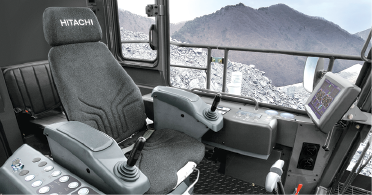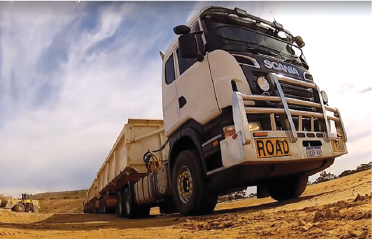Hitachi recently introduced five new electric-powered, mining-class excavators that, except for the absence of diesel engines and their ancillary systems such as fuel tanks, mufflers, etc., are functionally identical to the company’s popular diesel-powered versions, such as the EX8000-6 shovel shown here.
Trucks, shovels and large wheel loaders have long been mainstays of primary production in most types of surface mining, and both original equipment manufacturers (OEM) and aftermarket suppliers can point to decades of giving their customers what they’ve asked for — higher truck-body and bucket payloads, lower cost of operation, improved operator safety and more — as a principal driving force that has kept truck/shovel mining at the forefront of the industry’s technological interest for so long.
In good times, miners ask for a lot — they love the big trucks, shovels and loaders that allow them to operate flexibly and move more dirt, with less people in the pit and fewer trucks on the haul roads, so when reports emerged from equipment auctions in Australia, where late-model wheel loaders that originally cost almost $3 million were being sold for high-five-figure bids; or from South America, where the world’s largest Caterpillar dealer reported that only one mine in that highly active mining region had submitted a public tender for ultra-class haulage trucks (four) in 2015, it effectively illustrated the depth of the industry’s slump.
In bad times, miners ask for less — a lot less. In fact, industry spending on big-ticket mobile surface equipment has been in a downward spiral for more than four years, dropping to a level in early 2016 that is about 75% less than the industry’s most recent spending peak in early 2012. The Parker Bay Co., a U.S.-based market research firm specializing in global surface-mining equipment sales and trends, recently released a market analysis for sales of high-capacity trucks, shovels and loaders (see sidebar) that explores this drop-off, noting that its results indicate “large surface mining equipment shipments…are now at levels not seen since the start of the commodities Super Cycle” — representing a 10-year low.
Expanding the Lineup
Despite the slump in equipment purchases, suppliers haven’t abandoned product-line expansion and upgrade programs. Last November, for example, Caterpillar introduced its 6015B diesel-powered excavator, featuring bucket capacity sized to cater specifically to applications in small mines and large earth-moving projects.

Inside the cab of Hitachi’s new electric-powered excavators, fluid-filled elastic mounts reduce shock and vibration by up to 30%, and an advanced multidisplay monitor provides key machine status information.
In February of this year, Hitachi Construction Machinery Americas introduced five electric mining shovels — the EX1900E-6, EX2600E-6, EX3600E-6, EX5600E-6 and EX8000E-6. Bucket capacities for the new models range from 11 m3 (14 yd3) for the smallest model to 40 m3 (52 yd3) for the top-of-the-line EX8000E-6.
Brian Mace, manager of HCM’s mining applications group, said Hitachi has offered electric excavators as part of its product line since the mid-1990s, but the new models are configured specifically for the U.S. and Latin American markets, where electrical power is provided at 60 Hz rather than the 50-Hz frequency common in other parts of the world. Because Canada and Australia impose a particular set of electrical power safety standards on this type of equipment, Hitachi is not quite ready to offer the new series in configurations eligible for use in those countries.
The electric-powered series are identical in most respects to Hitachi’s EX-6 series diesel-powered excavators — except, of course, for the absence of the diesel engine, fuel tanks and air-filtration/muffler systems, which results in the electrical models having an operating weight savings ranging up to 37 tons in the largest model, along with a corresponding lower ground pressure. The space normally taken up by the diesel models’ fuel tanks is used to house the electrical control cabinets in the electric models. The electric shovels also are equipped with a slip ring in the center joint to transmit power to the motor(s). Although the power-handling components on the electric machines are designed to work with either 50- or 60-Hz power, the mechanical gear ratios on the electric versions must be changed to maintain constant hydraulic pump speed at either frequency.
The five new electric models feature advanced Hitachi TFOA-KK motors designed to provide a cost-effective alternative to diesel-powered machines for mining operations where suitable electric power is available. Motor voltage ranges from 6,600 VAC to 6,900 VAC, providing rated continuous output rated at 610 kW on the EX1900E-6 up to 1,200 kW x 2 on the EX8000E-6.
Mace pointed out that a mine operator’s specific site or project characteristics can have a major influence on which type of machine would be more effective. Greenfield mine projects for which a reliable electrical power supply is not yet available would likely not be a good match for electric excavators, while an operation that must comply with local noise or exhaust-emission restrictions could benefit significantly from their use.
The need for a trailing power cable might put an electric model at a disadvantage vs. a diesel-powered unit at an operation that requires the highest level of mobile flexibility from its excavators. On the other hand, electric shovels models simplify daily maintenance — the machines do not require consumables such as engine oil, filters, coolant or fan belts. Engine-related components are also eliminated, such as radiators, air filters and mufflers. Service life of certain components may be extended due to the elimination of engine-generated heat.
As is the case with the diesel versions, the E-6 series electric drive excavator front attachments use welded, low-stress, high-tensile-strength steel for a full box section design that resists twisting and bending forces. The undercarriage for the five new models is identical to the diesel machines. The track shoes incorporate a triple grouser design and single roller; and roller guides are used to extend service life for track shoes. All of the five new shovels are equipped with Hitachi’s exclusive level crowding and arc digging system.
Inside the cab, fluid-filled elastic mounts reduce shock and vibration by up to 30% compared with rubber mounts, and an advanced multidisplay monitor provides operators with key machine status information. All of the shovels include Hitachi’s remote machine monitoring system, which provides access to machine data through Hitachi’s Global e-Service. Operating data are transmitted to a Hitachi server for processing, and then to customers and dealers.
All five electric shovels can be equipped with the optional SkyAngle system introduced on Hitachi’s mine truck line in 2012, designed to increase operator awareness by providing synthesized multiple images captured by cameras positioned at four locations on the shovel.
This article was adapted from the original, which was published in the April edition of Engineering & Mining Journal.

Swedish truck builder Scania is testing prototypes of its all-wheel-drive, in-pit/over-the-road haulers with driverless operation, and reports strong interest from Australian mining customers.
Looking Down the Road

Source: The Parker Bay Co.






